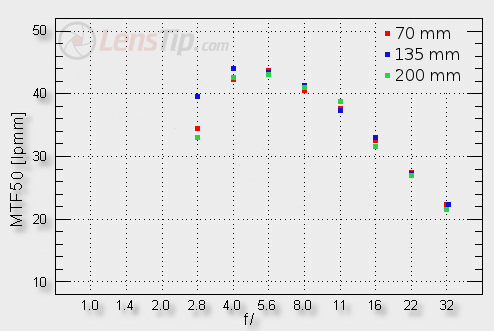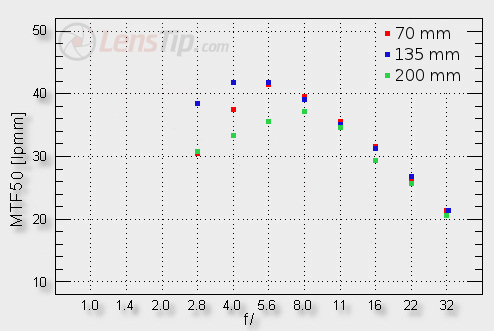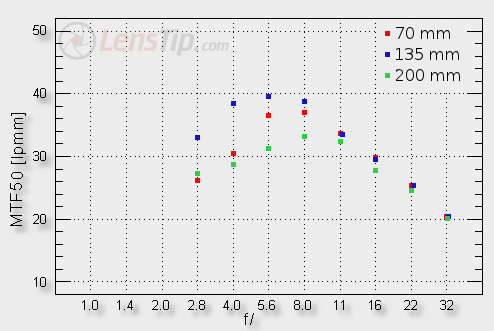Tamron SP 70-200 mm f/2.8 Di VC USD
4. Image resolution
Let’s glance at the graph below where you can see the results it got in the centre of the frame, on the edge of the APS-C sensor and on the edge of full frame.

Please Support UsIf you enjoy our reviews and articles, and you want us to continue our work please, support our website by donating through PayPal. The funds are going to be used for paying our editorial team, renting servers, and equipping our testing studio; only that way we will be able to continue providing you interesting content for free. |
- - - - - - - - - - - - - - - - - - - - - - - - - - - - - - - - - - - - - - - - - - - - - - - -
In the frame centre the lens presents itself very well. Already from f/4.0 you get the same values at all focal lengths. The resolution by f/4.0 and f/5.6 reaches 42-44 lpmm – really a high level. The maximum relative aperture is noticeably worse, though; you see a great result only at 135 mm focal length where the MTF go as high as 40 lpmm. At both extreme ends of focal range the values are far lower, getting to just 33-35 lpmm. Still they remain safely above the decency level.
How does Tamron compare with its rivals in this category? Unfortunately it lags behind them. The new, stabilized Canon 70-200 mm already at the maximum relative aperture can exceed 40 lpmm at all focal lengths, reaching a maximum value of 46-47 lpmm. The Nikkor 70-200 VR II fares a bit worse than the Canon but still it is able to defeat the Tamron. Even the Sigma 70-200 mm OS gets higher MTFs although its performance is a bit less even than that of the Tamron.
Although the comparison between the Tamron and its rivals is unfavourable for the tested lens you should put your assessment in the right perspective. This device isn’t too weak, it’s rather the competition which is sensationally good. The images provided by the new Tamron are of excellent quality and the lens fares here noticeably better than the old, brand-name devices with the same parameters.
The Tamron’s performance on the edge of the frame also places it in a good light. Let’s start with the edge of the APS-C sensor.

At the maximum relative aperture the Tamron not only generates useful photos but also it fares better than the Sigma and at 135 mm focal length – better than the brilliant Canon! What’s more, on slight stopping down the 70-135 mm range fares exceedingly well, momentarily providing the highest results of all 70-200 mm f/2.8 lenses, compared here. A round of applause!
In the case of fast zoom lenses the correction of optical aberrations on the edge of full frame is the biggest challenge. Let’s check how Tamron optics specialists dealt with that task.

The performance at both ends of focal length range while the lens is wide open can be a problem – the MTFs don’t even get to 30 lpmm. The results of the Canon were a bit higher. For a change, at 135 mm the Tamron fares better. It is worth noticing here that on the edge of full frame the Tamron performs noticeably better than the Sigma. Especially the performance at 70-135 mm focal lengths, on stopping down the aperture deserves to be praised. The Tamron, as the only lens among the 70-200 mm f/2.8 instruments, is able to reach almost 40 lpmm.
The assessment of the Tamron 70–200 mm f/2.8 VC in the resolution category can be only positive. It is, in fact, the most even lens from all 70-200 mm f/2.8 instruments. In the frame centre it loses slightly to its rivals (but still it is able to provide images of excellent quality) but on the edge of the frame it is able to defeat even the most renowned competitors.
At the end of this chapter traditionally we present crops from our resolution testing chart, taken from JPEG files.
 |






